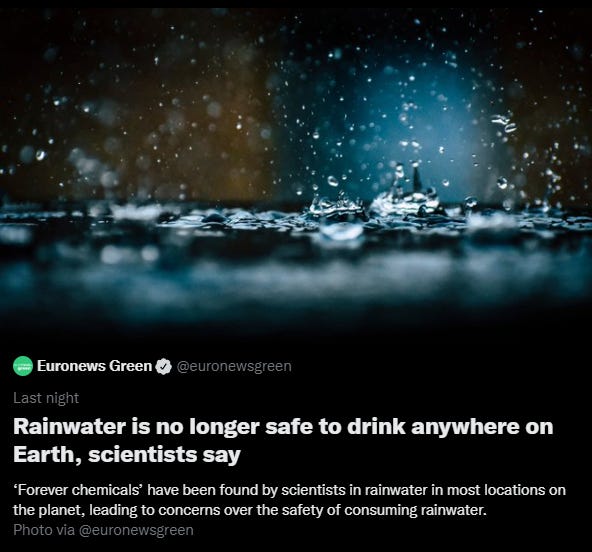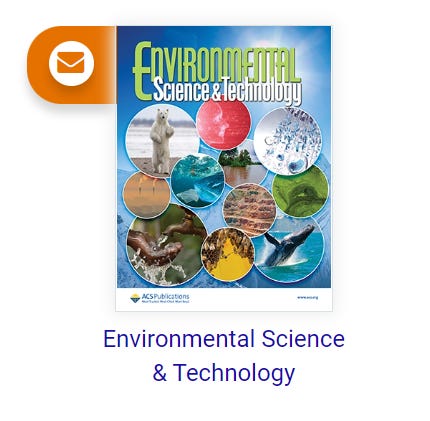I can’t believe I am talking about water again.
This week, a study about rainwater went super-viral when 1000s of tiny blue birds started screaming in unison. The finding? Rainwater is no longer safe to drink… anywhere on the planet. Cue the panic.
It provides a particularly interesting case study in press release science, “doomism” in headlines (particularly on Twitter) and erasing nuance and uncertainty from science narratives.
Here’s what happened.
Let’s just start with the headline, shall we?
Rainwater is no longer safe to drink anywhere on Earth, scientists say
It’s pretty unsettling when scientists are telling us rainwater is no longer safe to drink, not that most people reading would be drinking it — but it’s an immediately arresting headline because it speaks directly to how much humans have messed shit up on this planet (as if we needed more evidence).
Quickly, the science: PFAS, PFOA and PFOS are groups of hazardous chemicals that persist a long time in the environment. Some studies have linked the chemicals to diseases like cancer, in addition to developmental issues and problems with fertility but more research is needed. So, in short, they’re bad for us (they’re also bad for other life). We don’t think about them a lot, perhaps, but we’re exposed to them all the time — in things we eat, in air we breathe and yep, in water, too. These nasty bastards are everywhere. If that concerns you, read this to learn a bit more.
But let’s narrow our focus to reporting on this rainwater hullabaloo.
The article responsible for the inciting Twitter moment was written by Euronews Green and originally published on Aug. 4. Euronews Green is the climate change publication from European TV network Euronews. The piece in question leans heavily on a press release (we’ll get to that in a second) but just note that publication date: Aug. 4.
On publication it seemed that no one really cared all that much. It wasn’t picked up by many publications. But then it got a Twitter moment on Aug. 10.
The following day it exploded (probably because journalists frequent Twitter to cry and find stories). Even the ABC’s liveblog ended one of its updates discussing the news with “stay safe out there.” Yikes. Is it as bad as it seems?
The short answer is: Maybe, but we need a lot more nuance and tons more research.
First, let’s go back to the primary study. It was published in a journal called Environmental Science & Technology, by lead author Ian Cousins and colleagues, on Aug. 2 with the title:
Outside the Safe Operating Space of a New Planetary Boundary for Per- and Polyfluoroalkyl Substances (PFAS)
I’ll point out the journal has a good reputation and is associated with the American Chemical Society. All good stuff. No trouble here from what I can tell. I will also say that its online cover looks like a 90s educational CD-ROM cover, which I back.
I want to note one important point about the study. This piece of work is a peer-reviewed article, but it’s a Perspective article1. This means it’s not actually contributing new work, but rounding up the science that has already been performed and adding context — and its focused, not comprehensive, by definition. That’s not to take away from it at all, but some sites suggest this is “new research” and they attribute the findings to the the authors from Stockholm University. This is not the case. The work comes from scientists across the world and is a sort-of… review type article.
A press release accompanied the study’s publication on release (Aug. 2), published by Stockholm University and also republished by The Green Science Policy Institute2 on EurekAlert! (basically the chief press release clearing house for sciences).
It’s clear the Euronews Green piece went entirely off this press release, which was headlined (much less worryingly) “It’s raining PFAS.” The release does use a quote from lead author Cousins that mentions rainwater everywhere would be judged unsafe to drink based on the recently revised US Environmental Protection Agency guidelines. My god, that’s some big bulging nuance right there!
As more research has been performed on PFAS and related chemicals, the US EPA has brought down the acceptable levels in drinking water. In 2016, it was 70 parts per trillion. In June, interim guidelines were announced that brought that down to 4 parts per trillion.3 This revision was because of how PFAO, in particular, seemed to decrease antibodies in children after vaccination4. I have not seen this reported anywhere.
But want to know something… scary? That means the last US EPA guidelines from 2016 would also suggest rainwater “everywhere on Earth” is undrinkable.5
The headlines aren’t wrong so much as they just obliterate any nuance in favour of the infinitely more worrying idea that humans have completely messed up rain itself. They also leave room for the reader to go… well, fuck, this is terrible! I must learn more. This is, unsurprisingly, great for clicks and not so great for science communication.
One of the negative spinoffs of the way science moves from press release to publication is how the initial message gets reinterpreted over time and how that first piece kind of sets the agenda — even if it’s wholly lifted from a press release. Arguably (because I don’t have empirical data on this (yet)), this cycle always crescendos in the most overblown headlines.
We get a good example with this story: Suss “The South African,” which went with the headline:
Never drink rainwater! Study finds unsafe to drink due to chemicals6
What’s interesting is how this whole thing also relates to how we look at the world and frame our stories — and where most science journalism is coming from.
Fact: Rainwater across the world7 is unsafe according to the US EPA guidelines. These are, as I mentioned before, interim (as it stands) and the strictest in the world. We are still uncertain about the effects of PFOA, PFOS — don’t get me wrong, they’re likely not very good for us at all and it's probably good to be cautious here — but we need more research to understand exactly what limits we should be setting. If this study was using the Australian guidelines8, then rainwater would still be classified as safe to drink in pretty much all the places on Earth that are in the Perspective article, and definitely Antarctica and Tibet.
Another fact: These chemicals are everywhere and we don’t really know how to break them down. They’re called forever chemicals for a reason. That means they just keep cycling through the Earth’s systems over and over again. So we do want to get rid of them and we do want to know how harmful they are.
Last fact: Twitter, I am begging you to stop just promoting scary science things without doing some backgrounding. Like last week, with the Loch Ness story, it’s becoming pretty obvious that Twitter’s What’s Happening bar plays a major role in how far science stories travel — and how quickly and… incorrectly, at times.
I’ll dig into that sometime soon, perhaps in a bonus issue when I can get answers on what’s happening to What’s Happening.
Until then, stay hydrated… if you dare! *maniacal laughter*
BONUS: No Breakthroughs was on ABC’s Media Watch last week for the MAGIC WATER newsletter from two weeks ago! That’s a neat little life goal I can tick off. You can watch the whole segment right here.
And more structured water goodness? There’s also this illustration from @ivyhish, a great Australian science writer and editor of the 2022 Best Australian Science Writing anthology. This is generally how my newsletters are put together each week, with a crazy wall and angry-concerned look on my face. Thanks Ivy!!!!!!!
The different types of articles published by ACS journals are here: https://publish.acs.org/publish/author_guidelines
The Green Science Policy Institute is dedicated to promoting the “safer use of chemicals and chemical policies that protect public health”
Disclaimer: Please check my math. I am bad at this.
There are some critical points in the EPA Technical Documents worth looking at if you’re interested.
Again, please, the math. Check it.
I found this headline thanks to Andrew Revkin’s webcast on Aug. 13.
Even this is a little bit of a furphy because you could definitely argue every location isn’t evaluated, even if rainfall in Antarctica and Tibet have been.
CHECK MY MATH PLEASE (Aus guidelines for PFAO are 560,000 parts per trillion)








